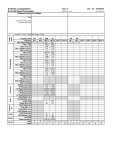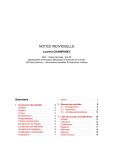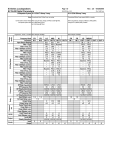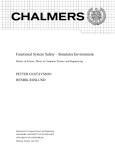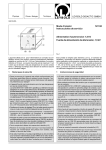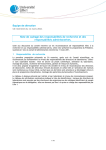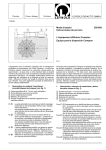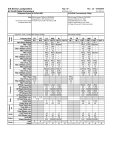Download GISM user manual 6.53-bis
Transcript
-1- Global Ionospheric propagation Model GISM USER MANUAL release n° 6.53 (January 2011) www.ieea.fr GISM_user_manual / v6.53 27/02/11 -2- GISM_user_manual / v6.53 27/02/11 TABLE OF CONTENTS 1. Introduction ............................................................................................................................................ 4 2. GISM implementation .................................................................................................................................. 6 2.1 Task 1: Create a project directory ....................................................................................................................... 6 2.2 Task 2: inputs ......................................................................................................................................................... 7 2.3 Task 3: Execute ...................................................................................................................................................... 7 3. Input data ...................................................................................................................................................... 8 3.1 Trajectory ............................................................................................................................................................... 9 3.1.1 GPS constellation ............................................................................................................................................................... 9 3.1.2 Glonass ............................................................................................................................................................................. 10 3.1.3 Galileo .............................................................................................................................................................................. 11 3.1.4 Orbit trajectory ................................................................................................................................................................. 11 3.2 Medium Description ............................................................................................................................................ 12 3.3 Geophysical Parameters ...................................................................................................................................... 12 3.4 Scintillation Analysis Parameters ....................................................................................................................... 13 3.5 Receiver Location................................................................................................................................................. 14 3.6 Map Analysis ........................................................................................................................................................ 14 3.7 Analysis Period of time ........................................................................................................................................ 14 3.8 Outputs options .................................................................................................................................................... 15 4. Output files .................................................................................................................................................. 16 4.1 History File ........................................................................................................................................................... 17 4.2 Mean effects synthesis.......................................................................................................................................... 18 4.3 Scintillations effects synthesis ............................................................................................................................. 19 4.4 Time series ............................................................................................................................................................ 20 5. Input Parameters Default Values............................................................................................................... 21 5.1 Medium’s definition ............................................................................................................................................. 21 5.2 Geophysical parameters ...................................................................................................................................... 22 5.3 Nequick model ...................................................................................................................................................... 23 6. Outputs ........................................................................................................................................................ 24 6.1 Time series ............................................................................................................................................................ 24 6.2 Average duration of fades ................................................................................................................................... 24 6.3 Spectrum ............................................................................................................................................................... 25 6.4 Maps ...................................................................................................................................................................... 26 7. Comparison with measurements ................................................................................................................ 27 www.ieea.fr -3- GISM_user_manual / v6.53 27/02/11 8. Examples ..................................................................................................................................................... 29 8.1 Scenarios ............................................................................................................................................................... 29 8.2 Simulation assuming static user and satellite constellation.............................................................................. 29 8.3 Simulation assuming static user and static satellite: point to point link ........................................................ 30 8.4 Static user + trajectory ........................................................................................................................................ 30 8.5 Maps ...................................................................................................................................................................... 31 9. Migrating from previous version to GISM version 6.53 ........................................................................... 32 10. References ................................................................................................................................................. 33 www.ieea.fr -4- GISM_user_manual / v6.53 27/02/11 1. Introduction As a result of propagation through ionosphere electron density irregularities, transionospheric radio signals may experience amplitude and phase fluctuations. In equatorial regions, these signal fluctuations specially occur during equinoxes, after sunset, and last a few hours. They are more intense in periods of high solar activity. These fluctuations result in signal degradation from VHF up to C band. They are a major issue for many systems including Global Navigation Satellite Systems (GNSS), telecommunications, remote sensing and earth observation systems. The signal fluctuations, referred as scintillations, are created by random fluctuations of the medium’s refractive index, which are caused by inhomogeneities inside the ionosphere. These inhomogeneities (or bubbles), or more generally the turbulences, develop under several deionization instability processes. These processes start after sunset when the sun ionization drops to zero, consequently at nighttime. To produce signal scintillation, the bubbles sizes should be below a typical dimension (typically one km) such that the diffracting pattern is inside the first Fresnel zone. The Fresnel zone dimension also depends on the distance from the Ionospheric Pierce Point (usually defined at about 350 km height) to the receiver and on the frequency. The Global Ionospheric Propagation Model (GISM), presented in this document aims to calculate these effects, in particular: • The Line of sight errors • The Faraday rotation effect on polarization: being an anisotropic medium, ionosphere layers will impact a linear polarized wave by rotating its polarization plane. • The propagation Delay: the ranging error is proportional to the TEC and to the inverse square of the frequency. • The scintillation effects: phase and amplitude scintillations, shorter correlation distances with respect to space, time and frequency, cycle slips, loss of lock. GISM model uses the Multiple Phase Screen technique (MPS). With this technique, the medium is divided into successive layers, each of them acting as a phase screen. The locations and altitudes of both the transmitter and the receiver are arbitrary. The link can consequently go through the entire ionosphere or through a small part of it. The whole calculation for one particular link is composed of two steps • • The calculation of the Line Of Sight (LOS) The calculation of scintillations The calculation of the Line of sight is done using a ray technique. GISM uses the NeQuick model to provide the value of the electron density inside ionosphere required at any time and location. At the end of this calculation the LOS errors, the Faraday rotation and the delays are calculated. The LOS being determined, the scintillations are then calculated. To do this, at each screen location along the line of sight, the parabolic equation (PE) is solved. This calculation requires the knowledge of the medium statistical characteristics. They are defined with respect to the ionosphere electron density mean value at all points along the LOS. www.ieea.fr -5- GISM_user_manual / v6.53 27/02/11 GISM model estimates the scintillation parameters from the knowledge of the time series at receiver level using the signal intensity and phase and its correlation and structure functions. In case of strong scintillations (typically S4 > 0.7), the phase may exhibit cycle slips with consequences on the receiver phase loop. It may also in that case lead to losses of lock for one or several satellites. GISM model allows considering either a trajectory described by a list of successive points or a constellation (GPS, Galileo or Glonass). An orbit generator has been introduced for this capability. The input in that case is the Yuma file. GISM allows considering either links, from a receiver to a satellite or a constellation, or maps. Details on the theoretical formulation and corresponding algorithm may be found in the GISM technical report [1], [2]. This document is organized as follows: Section 2 presents the code organisation Section 3 presents the input data Section 4 presents the output files Section 5 defines the input parameters default values Section 6 is related to the algorithm convergence Section 7 presents the mapping capability Section 8 is related to the output options Section 9 presents some input data files for typical scenarios Section 10 indicates the changes in the input data file with respect to the previous version. www.ieea.fr GISM_user_manual / v6.53 27/02/11 -6- 2. GISM implementation The 4 tasks required for execution are detailed below: - Task 1: Create a directory inside which will be located all files (input and output) related to the problem case. Task 2: Fill the input data file. Task 3: Define the satellite location and trajectory. Task 4: Run a test case. 2.1 Task 1: Create a project directory Each problem will correspond to a specific directory. This is the first task to be completed by the user. This directory shall be located inside directory Scenarios. Before GISM execution, this directory must contain two files. The first one named data.txt contains the link or map data. The second one is the satellite trajectory. GISM Scenarios Case N° 1 Case N° 2 Data.txt Yuma file Figure 1: GISM implementation The executable file must be at the same level than Scenarios and bin. www.ieea.fr bin ihm …. -7- GISM_user_manual / v6.53 27/02/11 2.2 Task 2: inputs • • create the data.txt file inside the corresponding folder Include a trajectory file in the project folder For GPS: a Yuma file. GPS Yuma files can be downloaded from http://www.navcen.uscg.gov/ftp/GPS/almanacs/yuma/ For Glonass : a Yuma file. The Glonass Yuma file contains one additional datum for the frequency dependency of the satellite. The corresponding files are stored for Galileo. For a trajectory: a .txt file containing the trajectory. 2.3 Task 3: Execute Once, the data file and the trajectory file are properly created and stored in a directory, the execution can be launched from a DOS window. - gism project_name on a DOS window; www.ieea.fr -8- GISM_user_manual / v6.53 27/02/11 3. Input data The input data file must be saved inside the directory corresponding to the problem of interest. The following sections may be addressed: Satellite position One of the following options: gps ; glonass ; galileo ; point_2_point ; orbit_trajectory Medium description slope ; BubblesRMS ; OuterScale All these parameters are optional. Default values are assigned to each one. Geophysical parameters flux_number ; vdrift Scintillation analysis parameters frequency same_seed (optional) LOSSpaceStep (the space step along the line of sight: optional) Receiver Location receiver Map Analysis GlobalMap Analysis Period of time time_window ; time_start, date tgps ; UT ; SLT Outputs options sampling_frequency; average_duration_of_fades ; spectrum All these keywords are optional Keyword List Project_name gps, glonass, Galileo, point_2_point, orbit_trajectory slope, BubblesRMS, Outerscale flux_number, vdrift frequency, same_seed, LOSSpaceStep, receiver GlobalMap time_window, time_start, date tgps, UT, SLT sampling_frequency, average_duration_of_fades, spectrum www.ieea.fr GISM_user_manual / v6.53 27/02/11 -9- 3.1 Trajectory The satellite location may be defined by one of the following options : gps ; glonass ; galileo ; Point2Point ; OrbitTrajectory. 3.1.1 GPS constellation Yuma files are used. GPS Yuma files can be downloaded from http://www.navcen.uscg.gov/ftp/GPS/almanacs/yuma/ GPS Yuma file example : ******** Week 109 almanac for PRN-01 ******** ID: 01 Health: 000 Eccentricity: 0.5046367645E-002 Time of Applicability(s): 319488.0000 Orbital Inclination(rad): 0.9655654054 Rate of Right Ascen(r/s): -0.7943188009E-008 SQRT(A) (m 1/2): 5153.693359 Right Ascen at Week(rad): 0.1580654101E+001 Argument of Perigee(rad): -1.732023850 Mean Anom(rad): 0.1213174697E+001 Af0(s): 0.1964569092E-003 Af1(s/s): 0.0000000000E+000 week: 109 constellation parameters : printed in the history file PRN Semi-major axis 1 2 3 4 5 6 7 8 9 10 11 13 14 15 17 18 20 21 22 23 24 25 26 27 28 29 30 31 26560.555 26559.529 26559.855 26558.496 26558.809 26559.604 26560.711 26560.350 26560.127 26559.680 26560.102 26560.012 26559.840 26559.725 26560.027 26559.559 26560.625 26559.398 26558.910 26556.625 26559.125 26561.018 26560.430 26559.740 26572.707 26562.156 26559.459 26559.826 Eccentricity 0.505E-02 0.213E-01 0.238E-02 0.556E-02 0.312E-02 0.685E-02 0.121E-01 0.815E-02 0.123E-01 0.449E-02 0.995E-03 0.184E-02 0.224E-02 0.806E-02 0.135E-01 0.236E-02 0.221E-02 0.177E-01 0.145E-01 0.156E-01 0.938E-02 0.906E-02 0.131E-01 0.153E-01 0.531E-02 0.843E-02 0.585E-02 0.103E-01 Inclination 55.323 53.464 53.588 55.743 53.640 54.021 54.122 54.966 54.171 56.097 52.749 55.563 55.258 56.114 56.222 55.108 55.150 56.077 53.436 56.263 56.323 53.757 55.487 54.017 54.992 55.308 54.047 54.090 www.ieea.fr Argument of perigee -99.238 -115.284 29.984 -24.585 25.810 -128.902 -114.051 117.344 43.545 4.843 -133.675 6.589 -28.220 100.564 -178.768 159.857 121.231 -138.349 40.565 -104.139 -93.038 -111.155 16.709 -145.610 -137.061 -106.837 77.274 49.513 RAAN 90.565 -155.177 -93.358 -29.194 -153.976 -90.729 -92.447 151.123 148.044 29.482 -33.650 89.356 89.114 -26.577 -24.278 32.216 29.231 29.821 -154.405 32.249 -28.230 145.591 89.632 146.944 -150.616 87.942 -151.998 -92.451 Mean anomaly 69.510 -103.414 -178.421 25.230 13.929 74.593 -170.945 91.425 59.600 -100.709 -124.151 -68.616 102.658 112.876 48.302 9.208 -88.161 -84.738 -122.015 -61.685 63.017 107.498 165.750 21.611 -68.702 162.146 -69.371 130.243 - 10 - GISM_user_manual / v6.53 27/02/11 3.1.2 Glonass Glonass Yuma file example : ******** Week 109 almanac for PRN-01 ******** ID: 01 Health: 000 Eccentricity: 0.5046367645E-002 Time of Applicability(s): 319488.0000 Orbital Inclination(rad): 0.9655654054 Rate of Right Ascen(r/s): -0.7943188009E-008 SQRT(A) (m 1/2): 5153.693359 Right Ascen at Week(rad): 0.1580654101E+001 Argument of Perigee(rad): -1.732023850 Mean Anom(rad): 0.1213174697E+001 Af0(s): 0.1964569092E-003 Af1(s/s): 0.0000000000E+000 week: 109 frequency channel: 8 The Glonass Yuma file includes one additional line with respect to GPS Yuma file. This additional line specifies the frequency channel of the corresponding PRN required for the frequency calculation which depends on the PRN for the Glonass constellation. www.ieea.fr GISM_user_manual / v6.53 27/02/11 - 11 - 3.1.3 Galileo In case of Galileo, no Yuma file is required. The data is already stored. The corresponding values are reproduced below. constellation parameters : printed in history file PRN Semi-major axis 1 2 3 4 5 6 7 8 9 10 11 12 13 14 15 16 17 18 19 20 21 22 23 24 25 26 27 28 29 30 29993.711 29993.711 29993.711 29993.711 29993.711 29993.711 29993.711 29993.711 29993.711 29993.711 29993.711 29993.711 29993.711 29993.711 29993.711 29993.711 29993.711 29993.711 29993.711 29993.711 29993.711 29993.711 29993.711 29993.711 29993.711 29993.711 29993.711 29993.711 29993.711 29993.711 Eccentricity 0.000E+00 0.000E+00 0.000E+00 0.000E+00 0.000E+00 0.000E+00 0.000E+00 0.000E+00 0.000E+00 0.000E+00 0.000E+00 0.000E+00 0.000E+00 0.000E+00 0.000E+00 0.000E+00 0.000E+00 0.000E+00 0.000E+00 0.000E+00 0.000E+00 0.000E+00 0.000E+00 0.000E+00 0.000E+00 0.000E+00 0.000E+00 0.000E+00 0.000E+00 0.000E+00 Inclination Argument of perigee 56.000 56.000 56.000 56.000 56.000 56.000 56.000 56.000 56.000 56.000 56.000 56.000 56.000 56.000 56.000 56.000 56.000 56.000 56.000 56.000 56.000 56.000 56.000 56.000 56.000 56.000 56.000 56.000 56.000 56.000 0.000 0.000 0.000 0.000 0.000 0.000 0.000 0.000 0.000 0.000 0.000 0.000 0.000 0.000 0.000 0.000 0.000 0.000 0.000 0.000 0.000 0.000 0.000 0.000 0.000 0.000 0.000 0.000 0.000 0.000 RAAN Mean anomaly 0.000 0.000 0.000 0.000 0.000 0.000 0.000 0.000 0.000 120.000 120.000 120.000 120.000 120.000 120.000 120.000 120.000 120.000 240.000 240.000 240.000 240.000 240.000 240.000 240.000 240.000 240.000 0.000 120.000 240.000 0.000 40.000 80.000 120.000 160.000 200.000 240.000 280.000 320.000 13.330 53.330 93.330 133.330 173.330 213.330 253.330 293.330 333.330 26.660 66.660 106.660 146.660 186.660 226.660 266.660 306.660 346.660 20.000 20.000 20.000 3.1.4 Orbit trajectory #orbit_trajectory File name Coordinate system Two possibilities: • • ECEF : relative time along the trajectory (s.) & x, y z coordinates (m) in the earth referential. latitude, longitude, altitude (km with respect to ground) plus relative time (hrs) along the trajectory. A calculation is performed for each line of the trajectory file. In both cases, the time considered is a relative time along the trajectory. The initial time is defined by the time_start keyword #time_start monday 14 03 1999 20 00 0 www.ieea.fr - 12 - GISM_user_manual / v6.53 27/02/11 3.2 Medium Description slope ; BubblesRMS ; OuterScale All these parameters are optional. Default values are assigned to each one. Examples #slope 4 #BubblesMS 0.1 #OuterScale 500. ! (in meters) 3.3 Geophysical Parameters Flux_number ; vdrift The Flux number is the solar spot number. The ITU recommendation is to limit this value to 193. However this limitation has been removed in the NeQuick2 version used in GISM. Example: #flux_number 150.0 #vdrift 100. ! (in meters / second) www.ieea.fr - 13 - GISM_user_manual / v6.53 27/02/11 3.4 Scintillation Analysis Parameters frequency same_seed (optional) LOSSpaceStep (the space step along the line of sight: optional) #frequency range first frequency, step, number of frequencies ! (the first two values in MHz) or #frequency L1 or L2 or L5 or E1 or E2 or E5 or E6 or #frequency other value ! (in MHz) #same_seed This keyword allows running several cases in the same conditions, to obtain in particular the frequency correlation. GISM uses a random number generator. The seed is the PC clock. If the “same seed” keyword is used, the seed will be identical for successive runs. #LOSSpaceStep 15.e3 ! (in meters) This keyword is optional. It allows defining a space step along the Line Of Sight. The default value is 15 km (as above). The algorithm convergence with the space step value is commented at section 6. www.ieea.fr - 14 - GISM_user_manual / v6.53 27/02/11 3.5 Receiver Location #receiver Name of receiver Latitude (degrees, minutes, seconds), longitude (degrees, minutes, seconds), altitude (meters) Example: #receiver MarakParak 6 0 0 116 0 0 0.0 ! latitude (degrees, minutes, seconds), longitude (degrees, minutes, seconds), altitude ! the first 6 data integer, the last one real 3.6 Map Analysis GlobalMap Example: #GlobalMap -50 0 0 2 0 0 51 !latitude minimum(degrees, minutes seconds) step latitude (id.), number of steps -100 0 0 2 0 0 76 !longitude minimum(degrees, minutes seconds) step longitude (id.), number of steps ! all values integer 3.7 Analysis Period of time time_window ; time_start ; date UT ; SLT ; tgps If the calculation applies to a GPS constellation, the time window shall be specified. If the calculation applies to a satellite defined by its trajectory, the initial time and date shall be initialised. If the calculation applies to a Global or regional map, the date shall be specified. GPS, UT or Solar Local Time (UT - longitudinal delay) can be considered. Examples: #time_window Tuesday 11 05 2001 20 0 0 ! start of analysis : day name, date (day, month, year), hour, minute, second Tuesday 11 05 2001 21 0 0 ! end of analysis : day name, date (day, month, year), hour, minute, second 050 ! time step : hour, minute, second ! all values integer #time_start Tuesday 11 05 2001 20 0 0 ! start of analysis : day name, date (day, month, year), hour, minute, second ! all values integer #date Tuesday 11 05 2001 20 0 0 ! date of analysis : day name, date (day, month, year), hour, minute, second ! all values integer #UT or #SLT or #tgps www.ieea.fr - 15 - GISM_user_manual / v6.53 27/02/11 3.8 Outputs options sampling_frequency, average_duration_of_fades, spectrum All these keywords are optional Additional files will be created for each one of the above optional calculations. Each new link will add data to the files. In order to limit this size, it may be convenient to limit the creation of such files to one particular link. # sampling_frequency This will create time series files of intensity and phase. # average_duration_of_fades Performs the calculation of the average duration of fades #spectrum Calculates the spectrum of the intensity and phase of received signal. Examples: # sampling_frequency 100. 500. ! in Hz ! in seconds The first number (100 in the above example) is the sampling frequency The second number (500) is the sample time duration. # average_duration_of_fades #spectrum www.ieea.fr GISM_user_manual / v6.53 27/02/11 - 16 - 4. Output files Inside the folder corresponding to the problem under analysis, the following files are created during execution : - one « history file », one file for the mean errors synthesis, one file for the scintillation errors synthesis, one summary file. - n files for the mean errors, n files for the scintillation errors, on option : n Rinex files : signal + scintillation noise (amplitude and phase). GISM Scenarios Case N° 1 Case N° 2 Data.txt Yuma file history.txt mean_effects_synthesis.txt scintillations_synthesis.txt Summary.txt Ground_station_name _date_prn_n°xx_mean_effects Ground_station_name _date_prn_n°xx_scintillations ….. Figure 2: Output files www.ieea.fr bin ihm …. GISM_user_manual / v6.53 27/02/11 - 17 - 4.1 History File File name : history.txt GISM v6.50 input data GPS constellation frequency = 1575.42 MHz ground station name : Kourou time of analysis : start = 20.000 hours LT end = 21.000 hours LT time step = 5.000 mn. Geophysical parameters F10.7 = 150.00 year 2004 month = 5 day of month = 11 yuma file for week number PRN Semi-major axis Eccentricity 3 26559.936 0.556E-02 5 26560.893 0.522E-02 6 26561.340 0.655E-02 10 26560.289 0.611E-02 14 26559.207 0.141E-02 15 26559.936 0.886E-02 16 26561.385 0.246E-02 18 26559.766 0.473E-02 21 26559.951 0.869E-02 22 26559.016 0.489E-02 25 26559.896 0.114E-01 26 26559.779 0.154E-01 29 26560.299 0.823E-02 30 26559.699 0.733E-02 Statistics... CPU time : Lecture des fichiers d'entree : Calcul scintillations : Post-traitement : Total : end of job 246 Inclination Argument of perigee 53.214 53.612 53.645 56.157 56.041 55.392 55.057 55.222 54.624 55.071 54.118 56.265 56.090 54.008 6 mn, 8.05 0.00 6 mn, 47.94 12 mn, 55.98 www.ieea.fr 31.199 47.594 -115.540 17.473 -83.299 127.520 -81.499 -169.252 171.048 -81.535 -90.580 33.316 -78.577 72.705 s s s s RAAN 1.384 -58.508 4.417 126.425 -174.372 69.978 -54.398 128.304 68.398 128.870 -119.146 -173.691 -175.553 -56.145 ( 47.43%) ( 0.00%) ( 52.57%) (100.00%) Mean anomaly 84.027 -99.658 -29.022 153.285 64.992 -35.291 -98.448 -112.793 -35.646 129.187 -3.335 58.514 -176.106 -159.797 GISM_user_manual / v6.53 27/02/11 - 18 - 4.2 Mean effects synthesis file name : mean_effects_buget_link_synthesis.txt Mean effects synthesis GISM v6.50 PRN UT Range LT azimut elevation sat._lat sat._long TEC Faraday Doppler shift Iono (Hz) (m.) rotation delay (deg) (deg) (deg) (deg) (deg) 6.33 49.74 0.47 36.28 19.78 59.90 60.16 29.34 13.26 7.81 5.64 43.07 38.64 -31.90 -56.04 -13.26 -53.04 -0.74 -44.54 23.94 8.40 -12.77 -22.43 12.28 348.64 348.21 52.95 270.39 248.46 319.87 303.77 301.87 258.04 26.08 31.63 324.01 127.95 21.25 6.67 52.36 40.56 34.37 23.45 71.11 112.85 19.22 12.72 45.41 -1.30 -0.05 0.01 0.14 0.43 -0.20 0.10 -0.55 -0.06 -0.10 -0.05 -0.37 0.0 0.0 0.0 0.0 0.0 0.0 0.0 0.0 0.0 0.0 0.0 0.0 20.62 3.42 1.08 8.44 6.54 5.54 3.78 11.46 18.19 3.10 2.05 7.32 4.39 49.15 37.36 21.63 62.39 59.07 31.61 12.37 8.34 5.88 40.65 40.26 -30.08 -15.31 -52.21 -2.81 -45.97 21.98 10.40 -14.77 -24.44 14.30 349.91 348.98 270.67 251.12 320.07 305.46 302.30 258.29 26.26 32.04 324.33 133.48 21.38 50.11 39.61 32.90 22.89 66.24 115.26 18.28 12.09 47.67 -1.34 -0.06 0.15 0.41 -0.18 0.10 -0.50 -0.13 -0.09 -0.04 -0.40 -3.9 -1.1 0.9 2.8 1.5 -1.3 3.1 -2.1 0.6 0.3 -3.2 21.51 3.45 8.08 6.38 5.30 3.69 10.67 18.58 2.95 1.95 7.68 operating frequency = 1575.420 MHz 5 6 10 15 16 18 21 22 25 26 29 30 23.06 23.06 23.06 23.06 23.06 23.06 23.06 23.06 23.06 23.06 23.06 23.06 20.00 20.00 20.00 20.00 20.00 20.00 20.00 20.00 20.00 20.00 20.00 20.00 28.16 113.68 145.26 275.63 220.71 14.83 199.14 345.04 293.20 95.19 106.78 16.31 12 satellites in view operating frequency = 1575.420 MHz 5 6 15 16 18 21 22 25 26 29 30 23.14 23.14 23.14 23.14 23.14 23.14 23.14 23.14 23.14 23.14 23.14 20.08 20.08 20.08 20.08 20.08 20.08 20.08 20.08 20.08 20.08 20.08 28.05 110.10 272.87 221.52 16.69 194.98 344.88 295.25 97.28 108.93 15.93 www.ieea.fr GISM_user_manual / v6.53 27/02/11 - 19 - 4.3 Scintillations effects synthesis File name : scintillations_synthesis.txt Scintillations synthesis ground station name : ground station coordinates : naha 26.00 longitude = latitude = 128.00 altitude = 0.00 PRN UT LT azimut (deg) elevation (deg) sat.lat (deg) sat.long (deg) S4 sigma_phi (rad) 1 3 11 13 15 22 25 27 31 12.500 12.500 12.500 12.500 12.500 12.500 12.500 12.500 12.500 21.033 21.033 21.033 21.033 21.033 21.033 21.033 21.033 21.033 224.788 27.133 191.439 265.269 37.594 80.219 146.836 317.379 312.017 23.640 49.421 27.762 23.124 6.569 35.307 5.651 26.532 66.814 -14.690 52.404 -23.118 11.346 55.137 25.043 -34.181 52.189 36.910 92.101 151.044 118.496 72.534 219.097 176.409 166.533 68.689 111.587 0.730 0.048 0.757 0.284 0.020 0.087 0.822 0.046 0.045 0.658 0.027 0.975 0.125 0.013 0.048 1.352 0.022 0.026 9 satellites in view ground station name : ground station coordinates : naha 26.00 longitude = latitude = 128.00 altitude = 0.00 PRN UT LT Angular error (mr) Coh. length (km) PLL (deg) DLL ( m.) C / N Proba of LoL 1 3 11 13 15 22 25 27 31 12.500 12.500 12.500 12.500 12.500 12.500 12.500 12.500 12.500 21.033 21.033 21.033 21.033 21.033 21.033 21.033 21.033 21.033 0.11 0.00 0.18 0.01 0.00 0.00 0.52 0.00 0.00 0.27 0.62 0.23 0.60 0.62 0.62 0.11 0.62 0.62 17.52 6.99 21.17 9.37 6.99 6.99 318.88 6.99 6.99 23.97 0.00 30.72 7.33 0.00 0.00 515.13 0.00 0.00 30.13 35.78 31.31 29.82 24.99 32.87 24.55 30.60 37.75 0.061 0.000 0.045 0.000 0.000 0.000 0.428 0.000 0.000 9 satellites in view www.ieea.fr - 20 - 4.4 Time series File name : time_series_date_prn_N°_freq_xxxx.txt The sampling frequency was set to 100 Hz in this example. www.ieea.fr GISM_user_manual / v6.53 27/02/11 - 21 - GISM_user_manual / v6.53 27/02/11 5. Input Parameters Default Values 5.1 Medium’s definition The medium is defined by three parameters: the fluctuations spectrum slope, the average size of inhomogeneities and the strength of fluctuations. The fluctuations spectrum slope The slope coefficient of the power law spectrum and the turbulence strength can be deduced from measurements. Figure 3 shows the slope value deduced from measurements in Cayenne recorded during the PRIS measurement campaign [3]. One week of 50 Hz raw data files was used to obtain these plots. A slope value equal to 3 is the most probable value. This is in agreement with what is usually considered in the literature [7]. The slope value decreases with time after sunset corresponding to the fact that the inhomogeneities sizes decreases with time after sunset. It should be noticed however that the PRIS measurement campaign was done in a year close to solar minimum. High solar activity values might be different, in particular for the strength. slope Power spectrum 5 4 p 3 2 1 0 0 2 4 6 8 10 12 14 Time after sunset Figure 3: Slope distribution GISM uses 1D phase screen. It has been shown [1] that using 1D phase screens to define the medium is equivalent to a 2D isotropic medium provided that the slope is increased by one. The GISM spectrum slope default value is set to 4. Average value of inhomogeneities dimension The inhomogeneities dimensions which contribute to scintillations are linked to the first Fresnel zone λ d with d the distance from the fluctuating medium to the receiver. In dimension given by expression the L band the dimension is a few hundreds of meters. The default value is set to 500 meters. www.ieea.fr - 22 - GISM_user_manual / v6.53 27/02/11 Fluctuation strength This parameter defines the RMS electron density value with respect to the mean value. 0.05 is an average value. 0.15 is considered as a maximum value. The default value is 0.1. 5.2 Geophysical parameters Flux number The flux number may be set to any value. The past and future values of this index are shown on the following plot taken from NOAA web site. Figure 4: Solar Spot Number Drift velocity The apparent drift velocity at receiver level, is a combination of ionosphere drift velocity and motion of the link ionosphere pierce point (IPP). The IPP motion modifies the fades duration. It can be an increase or a decrease depending on the geometry. It also depends on the magnetic field as a result of elongated bubbles in that direction [4], [5]. The IPP drift velocity default value is set to 100 m / s at low latitudes and to 1000 m / s at high latitudes www.ieea.fr - 23 - GISM_user_manual / v6.53 27/02/11 5.3 Nequick model NeQuick 2 used in GISM is the latest version of the NeQuick ionosphere electron density model developed at the Aeronomy and Radiopropagation Laboratory of the Abdus Salam International Centre for Theoretical Physics (ICTP) - Trieste, Italy with the collaboration of the Institute for Geophysics, Astrophysics and Meteorology of the University of Graz, Austria [6]. The NeQuick is a quick-run ionospheric electron density model particularly designed for transionospheric propagation applications. To describe the electron density of the ionosphere above 100 km and up to the peak of the F2 layer, the NeQuick uses a profile formulation which includes five semi-Epstein layers with modelled thickness parameters. Three profile anchor points are used: the E layer peak, the F1 peak and the F2 peak, that are modelled in terms of the ionosonde parameters foE, foF1, foF2 and M(3000)F2. These values can be modelled (e.g. ITU- R coefficients for foF2, M3000) or experimentally derived. A semiEpstein layer represents the model topside with a height-dependent thickness parameter empirically determined. The NeQuick package includes routines to evaluate the electron density along any ray-path and the corresponding Total Electron Content (TEC) by numerical integration. Figure 5: Example of NeQuick 2 profiles and TEC along ray-paths. Different colours correspond to different path elevation angles. 90º means vertical profile and TEC (from Radicella, 2009 [6]) www.ieea.fr GISM_user_manual / v6.53 27/02/11 - 24 - 6. Outputs 6.1 Time series time_series_11_9_2000_prn_30_freq_1575 time_series_11_9_2000_prn_30_freq_1575 800 10 600 0 phase (deg) intensity_(dB) 400 -10 200 0 -20 -200 -30 -400 -600 -40 0 100 200 300 400 0 500 100 200 Figure 6: Intensity and phase time series for S4 = 0.89 6.2 Average duration of fades average_duration_of_fades_prn_30 100 10 average_duration_(s.) 300 time_(s.) time_(s.) 1 0.1 0.01 0.001 -40 -30 -20 -10 0 fade_level_(dB) Figure 7: Average duration of fades for S4 = 0.89 www.ieea.fr 10 400 500 GISM_user_manual / v6.53 27/02/11 - 25 - 6.3 Spectrum 1 .10 Power densities 3 100 10 1 0.1 0.01 1 .10 3 1 .10 4 1 .10 5 1 .10 6 1 .10 3 0.01 0.1 1 10 frequency (Hz) Phase Amplitude Figure 8: Intensity and phase spectrum www.ieea.fr 100 - 26 - GISM_user_manual / v6.53 27/02/11 6.4 Maps Figure 9 shows the correspondence between a Total Electron Content (TEC) map and a scintillation map. Those two maps were obtained by modeling using NeQuick (Radicella, 2009) model for the TEC and GISM for scintillations. They correspond to vertical links. The electron density is consequently integrated along a vertical at each grid point on the map to get the TEC. Slant observations may however exhibit higher values. The propagation length inside the ionosphere would increase in that case and by consequence the levels obtained. Figure 9: TEC (left panel) and scintillation map (right panel) obtained by modeling Figure 9 was obtained with a solar radio flux at 10.7 cm set to 150. It corresponds to a high value. Universal time is 10 p.m. for the TEC map and 12 p.m. for the scintillation map. At this time the peak values for the TEC occur in the Pacific Ocean area. For the scintillations the time duration of the events is a few hours after sunset. This is what gives the model. Both plots reproduce the same features regarding the peak values on both sides of the magnetic equator. The values decrease increasing the latitude. For scintillations the model calculates the effects at the equatorial regions. The high latitudes regions are also concerned by this problem but this is not taken into account by the model. The TEC maximum is 80 TEC units which is a significant value. It is directly linked to the solar flux value. The peak value for the intensity RMS (S4 parameter) is 0.7. Such a value corresponds to strong fluctuations. It is also linked to the electron density levels. Depending on the signal to noise ratio, one receiver may lose lock at this level. www.ieea.fr GISM_user_manual / v6.53 27/02/11 - 27 - 7. Comparison with measurements The results reported hereafter are taken from the PRIS measurement campaign [3] carried out under one ESA / ESTEC contract. For this study, a number of receivers were deployed both at low and high latitudes, in particular in Vietnam, Indonesia, Guiana, Cameroon, Chad and Sweden. These receivers were dedicated receivers, operating at 50 Hz. A data bank has been constituted and the scintillation characteristics have been derived from an extensive analysis of this data bank. For assessment of the model performance, we have selected one week of measurements at Cayenne, French Guiana taken from the PRIS data bank. The results are presented on Figures below. S4 all satellites Cayenne days 314 to 319 : year 2006 Sigma Phi all satellites Cayenne, days 314 to 319 / year 2006 1 0.8 S4 0.6 0.4 0.2 1 -20 0 20 40 60 80 0.6 0.4 0.2 0 -40 0 -40 PRN2 PRN13 PRN10 PRN4 PRN24 PRN28 PRN17 PRN12 PRN8 PRN29 PRN26 PRN9 PRN6 PRN23 0.8 Sigma Phi (radian) PRN2 PRN13 PRN10 PRN4 PRN24 PRN28 PRN17 PRN12 PRN8 PRN29 PRN26 PRN9 PRN6 PRN23 100 -20 0 20 40 60 80 100 LT LT Figure 10: Intensity and phase scintillation indices measurements on GPS week N° 377 Cayenne day 314 / 2006 GISM Cayenne day 314 / 2006 GISM 1 1 0.8 S4 0.6 0.4 0.2 0.6 0.4 0.2 0 0 18 19 20 21 22 23 24 25 13 23 27 8 17 28 4 10 24 29 2 26 5 9 6 0.8 Sigma phi 13 23 27 8 17 28 4 10 24 29 2 26 5 9 6 18 LT 19 20 21 22 23 24 25 LT Figure 11: Intensity and phase scintillation indices on day 314, GPS week N° 377, obtained by modeling Measurements The local time corresponds to hours in GPS time. Each point corresponds to a 1 mn sample. Only points with a S4 value greater than 0.2 were retained in the analysis. The points are clustered every evening at post sunset hours. The scintillation activity occurred quite regularly that week with comparable levels. The S4 average value is about 0.4. The flux number that week (GPS week N° 377) was equal to 90. The phase fluctuations are plotted concurrently. The mean value is about 0.2, consequently lower than the S4 value. This observation is quite general. In addition, it has to be noticed that some points exhibit high values. This is due to phase jumps. www.ieea.fr - 28 - GISM_user_manual / v6.53 27/02/11 Modelling The case was replayed one day using the Yuma files. Another week day will not bring significant differences considering that the geophysical parameters would have been quite identical. As mentioned previously, the model provides a mean value. It overestimates the number of affected links due to the fact that the probability of occurrence is not considered. Only the mean values can be compared. For the intensity, they compare quite well. It is about 0.4 in both cases. For the phase, the mean measurements value is around .2. The value obtained by modelling is slightly greater. In both cases the phase RMS is lower than the intensity RMS and in both cases some points exhibit high values due to the phase jumps. www.ieea.fr - 29 - GISM_user_manual / v6.53 27/02/11 8. Examples 8.1 Scenarios The scenarios considered are: • • • • Simulation assuming static user and satellite constellation Simulation assuming static user and static satellite i.e. a point to point link, Simulation assuming static user and moving satellite (trajectory, specific locations and times) Global and regional maps of vertical S4 and σφ. The input data files for each one of these different cases are presented in the next sections. 8.2 Simulation assuming static user and satellite constellation Input data file #gps Yuma246.txt #frequency L1 #SLT #time_window tuesday 11 05 2004 20 0 0 wednesday 11 05 2004 20 0 0 050 #flux_number 150.0 # receiver Cayenne 4 49 27 307 38 12 0. www.ieea.fr GISM_user_manual / v6.53 27/02/11 - 30 - 8.3 Simulation assuming static user and static satellite: point to point link Input data file #point_2_point 0. -35. 3.65E4 #frequency L1 #UT #time tuesday 11 10 2004 0 0 0 tuesday 11 10 2004 7 0 0 0 12 0 #flux_number 193. #receiver Kourou 5 4 48 -53 22 12 0. 8.4 Static user + trajectory Input data file #orbit_trajectory satellite_trajectory.txt geodetic #frequency L1 #SLT #time_start monday 14 09 2000 21 00 0 #flux_number 150.0 #receiver MarakParak 6 0 0 116 0 0 0.0 orbit_trajectory.txt time(s.) 600.0000 1200.000 1800.000 2400.000 3000.000 3600.000 4200.000 4800.000 5400.000 6000.000 6600.000 7200.000 7800.000 8400.000 9000.000 9600.000 10200.00 10800.00 11400.00 12000.00 latitude 2.000000 4.000000 6.000000 8.000000 10.00000 12.00000 14.00000 16.00000 18.00000 20.00000 22.00000 24.00000 26.00000 28.00000 30.00000 32.00000 34.00000 36.00000 38.00000 40.00000 www.ieea.fr longitude altitude(km.) 5.000000 28000. 10.00000 28000. 15.00000 28000. 20.00000 28000. 25.00000 28000. 30.00000 28000. 35.00000 28000. 40.00000 28000. 45.00000 28000. 50.00000 28000. 55.00000 28000. 60.00000 28000. 65.00000 28000. 70.00000 28000. 75.00000 28000. 80.00000 28000. 85.00000 28000. 90.00000 28000. 95.00000 28000. 100.0000 28000. - 31 - 8.5 Maps Input data file #GlobalMap -85. 0 0 5 0 0 35 -180 0 0 5 0 0 73 #date monday 1 1 2003 22 0 0 #flux_number 150.0 #frequency L1 www.ieea.fr GISM_user_manual / v6.53 27/02/11 - 32 - 9. Migrating from previous version to GISM version 6.53 Satellite trajectory The keyword time was renamed in time_window For a satellite trajectory, the keyword time_start shall be used Maps GlobalMap instead of map_coordinates keyword date as before maps_flux_number replace by flux_number maps_frequency replaced by frequency www.ieea.fr GISM_user_manual / v6.53 27/02/11 - 33 - GISM_user_manual / v6.53 27/02/11 10. References [1] [2] [3] [4] [5] [6] [7] Béniguel Y., “A Global Ionosphere Scintillation Propagation Model for Equatorial Regions”, submitted to Space Weather Space Science (SWSC). Béniguel Y., “Global Ionospheric Propagation Model (GIM): a propagation model for scintillations of transmitted signals”, Radio Sci., Vol 37, N° 3, May 2002. Béniguel Y., J-P Adam, N. Jakowski, T. Noack, V. Wilken, J-J Valette, M. Cueto, A. Bourdillon, P. Lassudrie-Duchesne, B. Arbesser-Rastburg, 2009, Analysis of scintillation recorded during the PRIS measurement campaign, Radio Sci., 44, doi 1029/2008RS004090. Kintner P, H. Kil, T. Beach, E. de Paula, « Fading timescales associated with GPS signals and potential consequences », Radio Science, Vol. 36, N°4, 731-743. DasGupta A., A. Paul, S. Ray, A. Das, S. Ananthakrisnan, “ Equatorial bubbles as observed with GPS measurements over Pune, India”, Radio Science, 2006, Vol 41, RS5S28 Radicella S.M.: "The NeQuick model genesis, uses and evolution", Annales of Geophysicae, Vol. 52, N. 3/4, June/August 2009 Wernik A., L. Alfonsi, M. Materassi, Scintillation modeling using in situ data, Radio Sci., Vol. 42, (2007), doi:0.1029/2006RS003512 www.ieea.fr

































